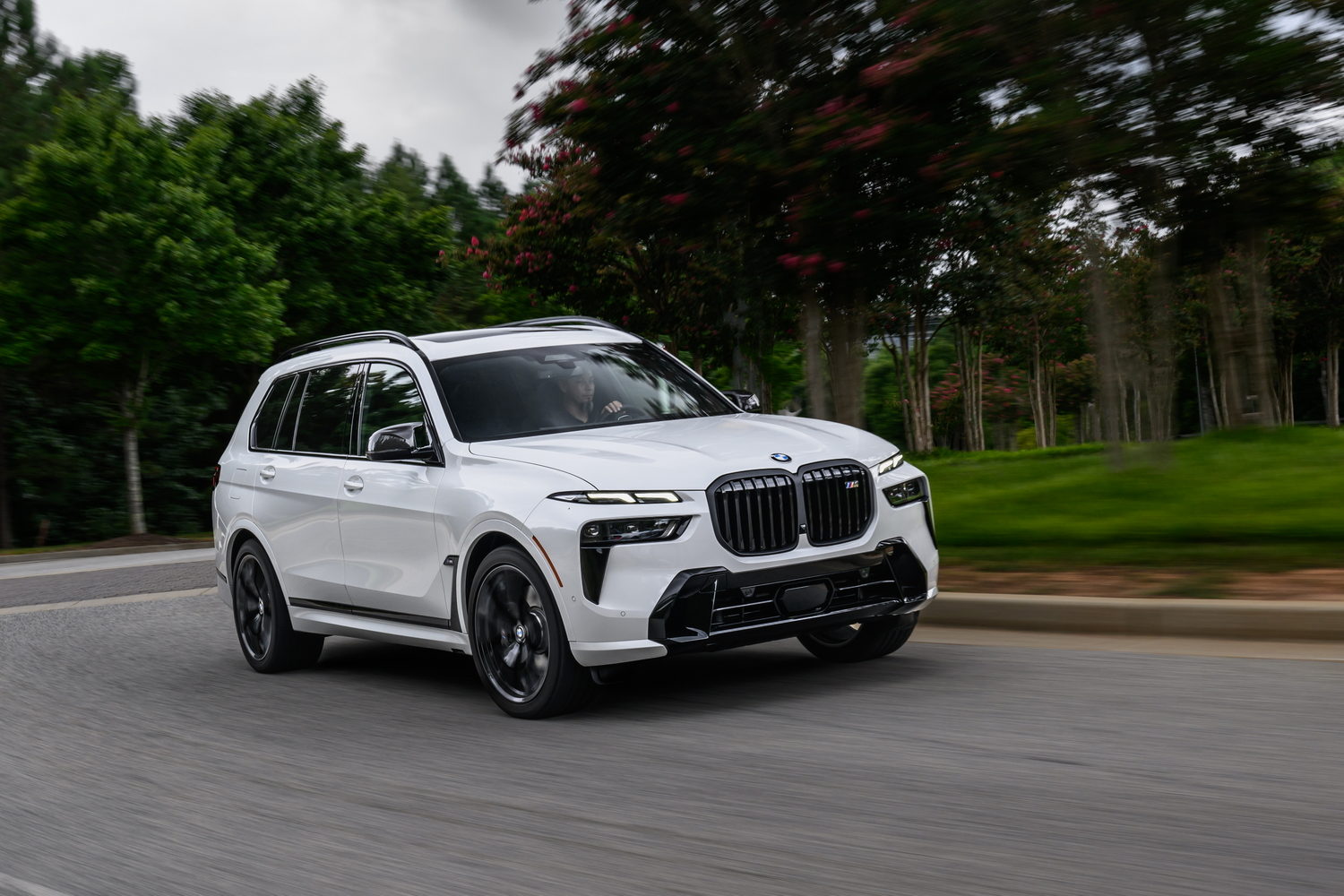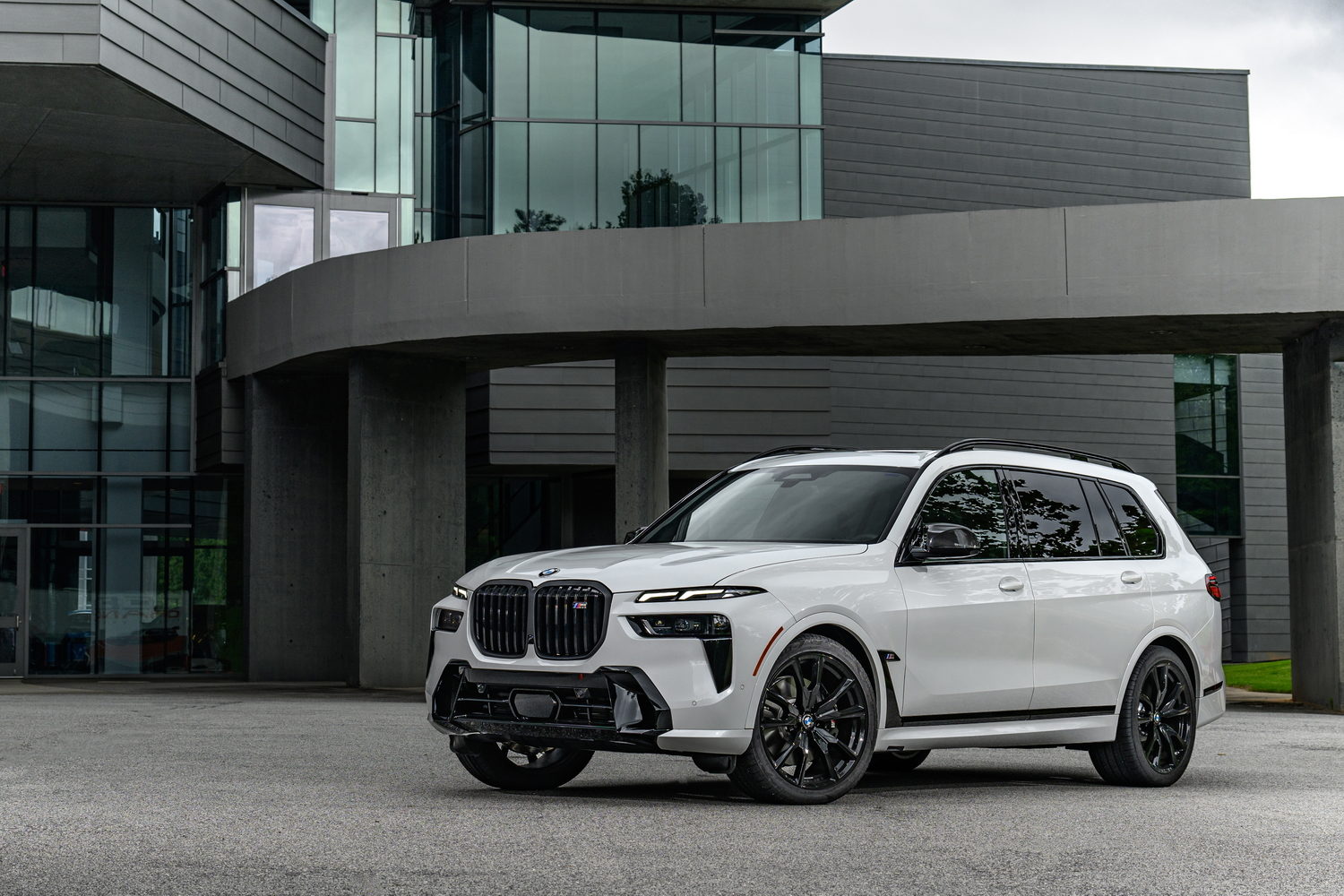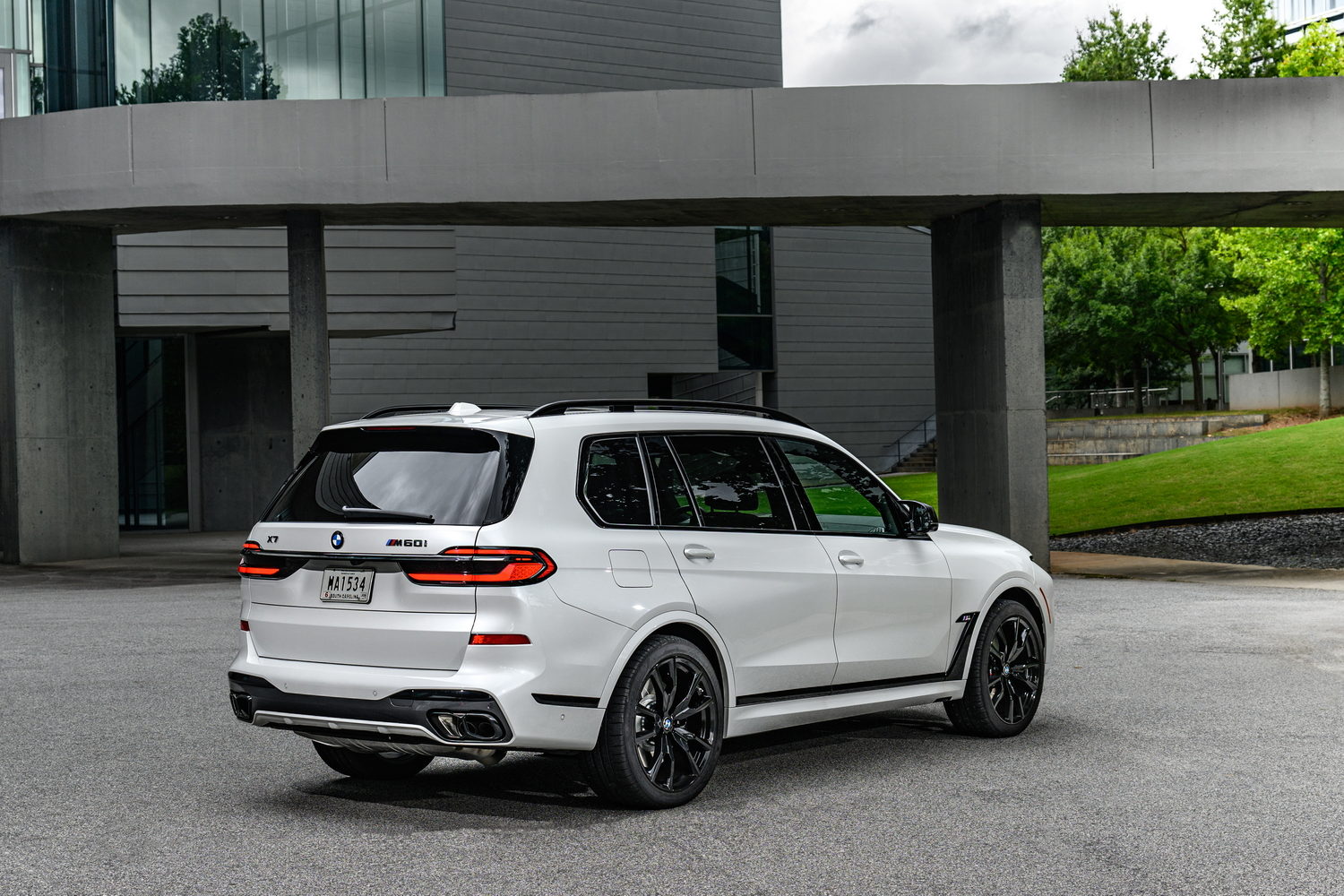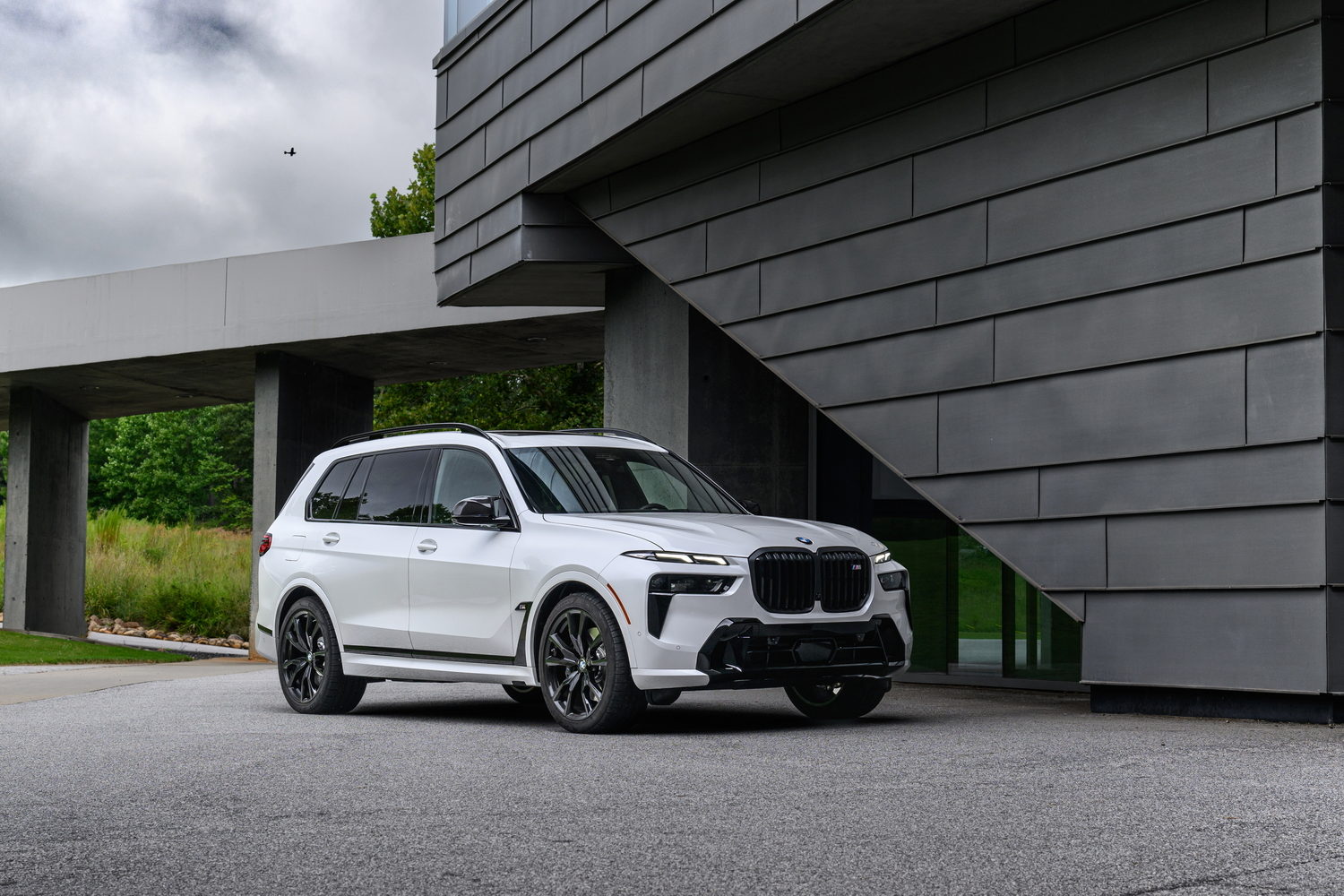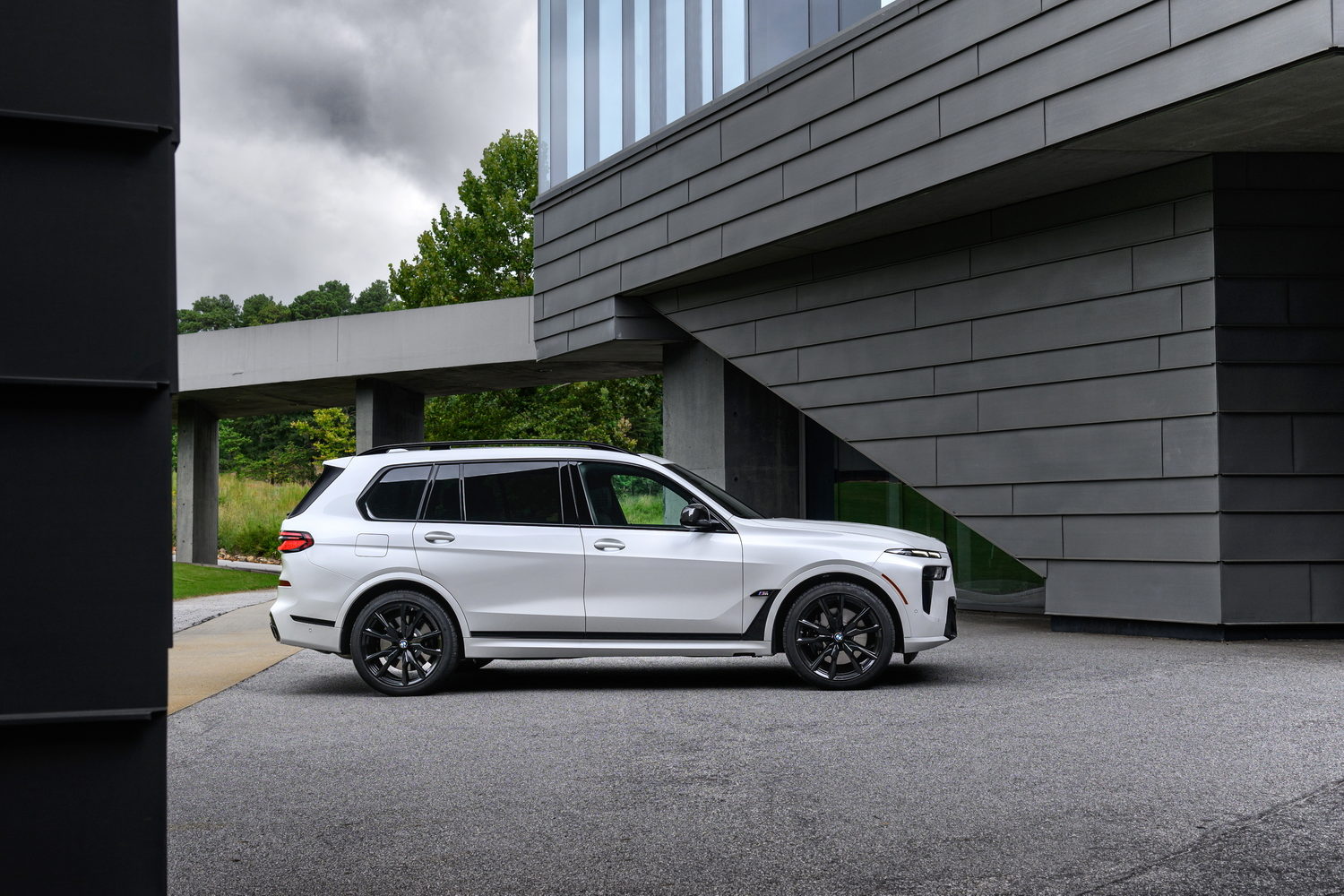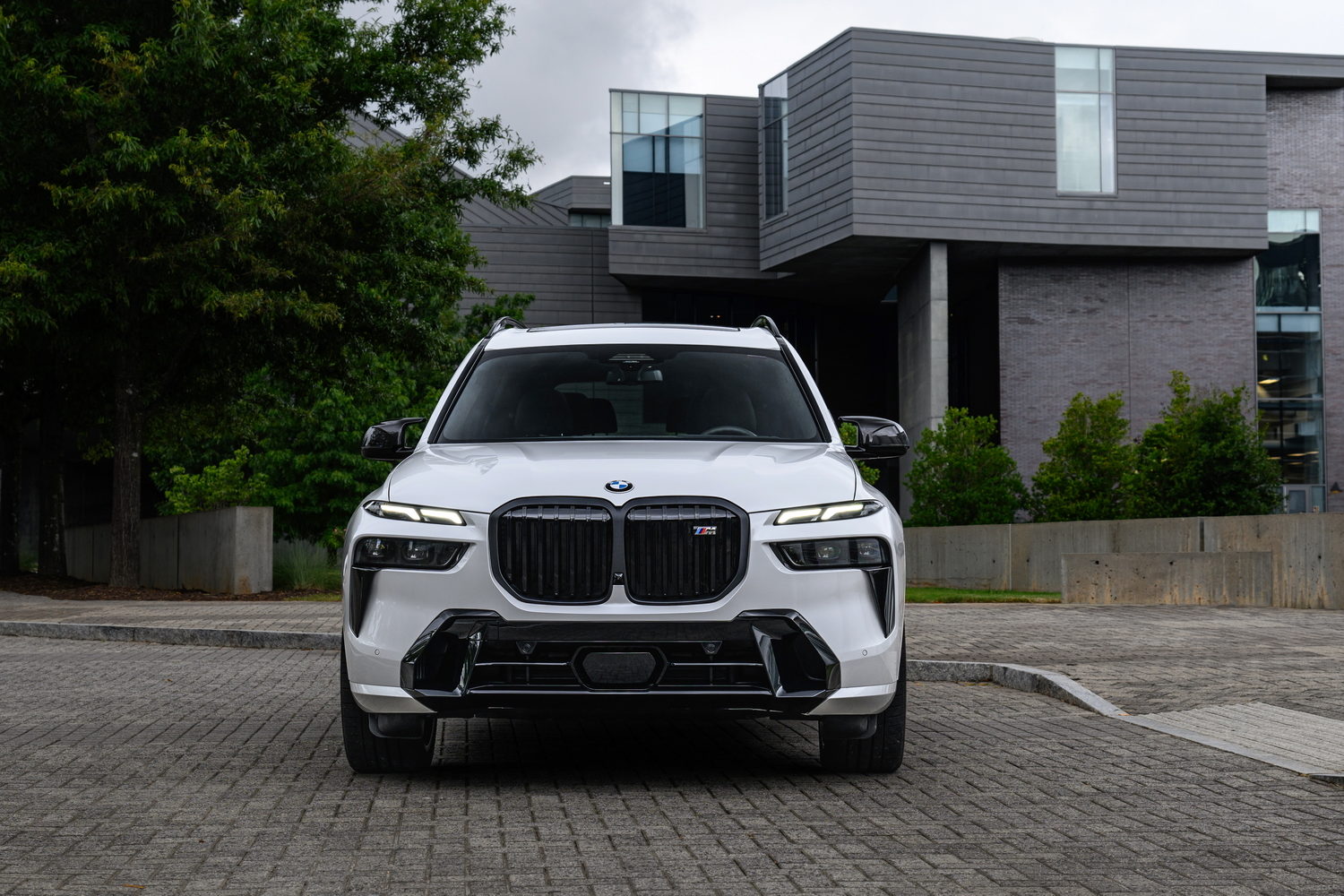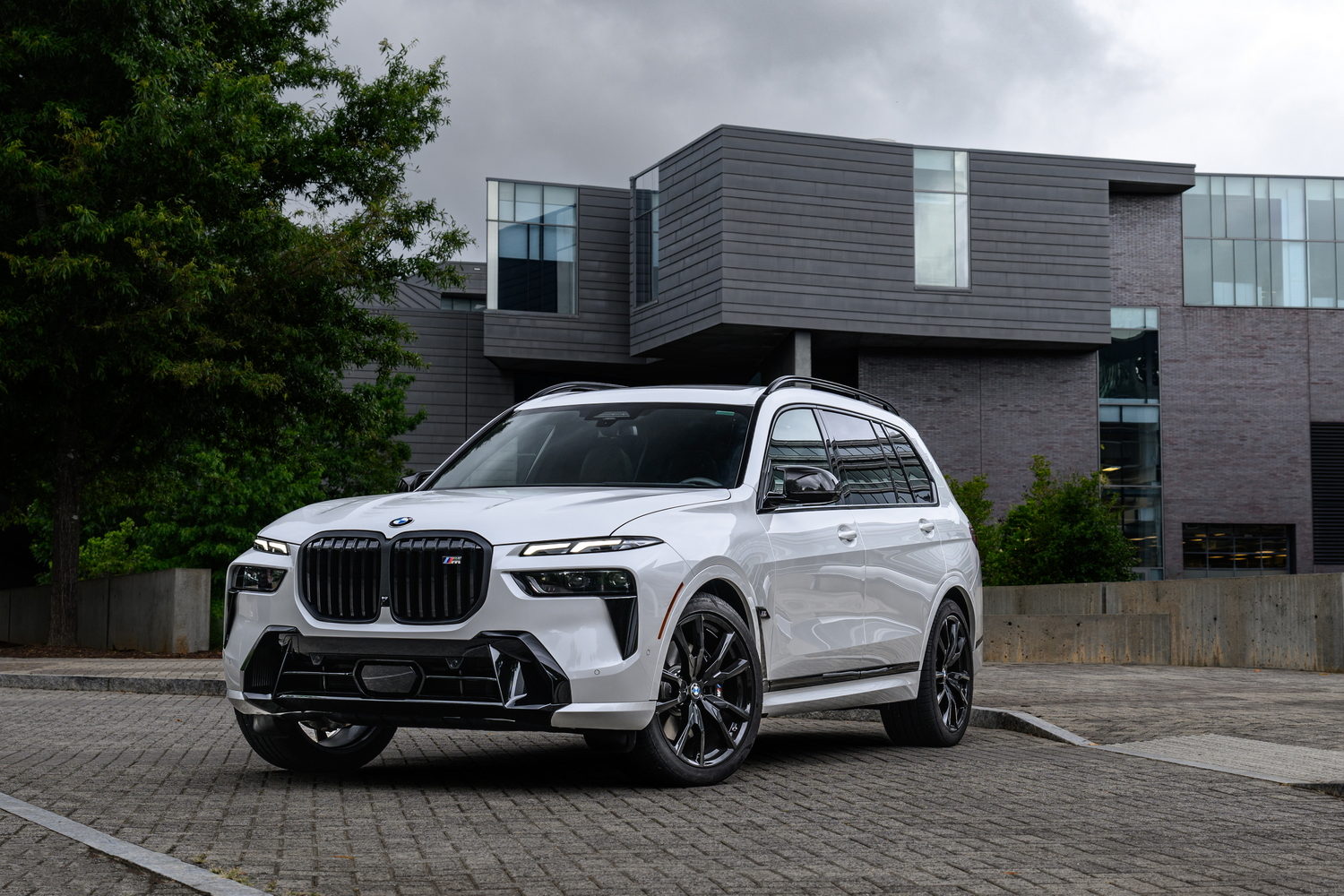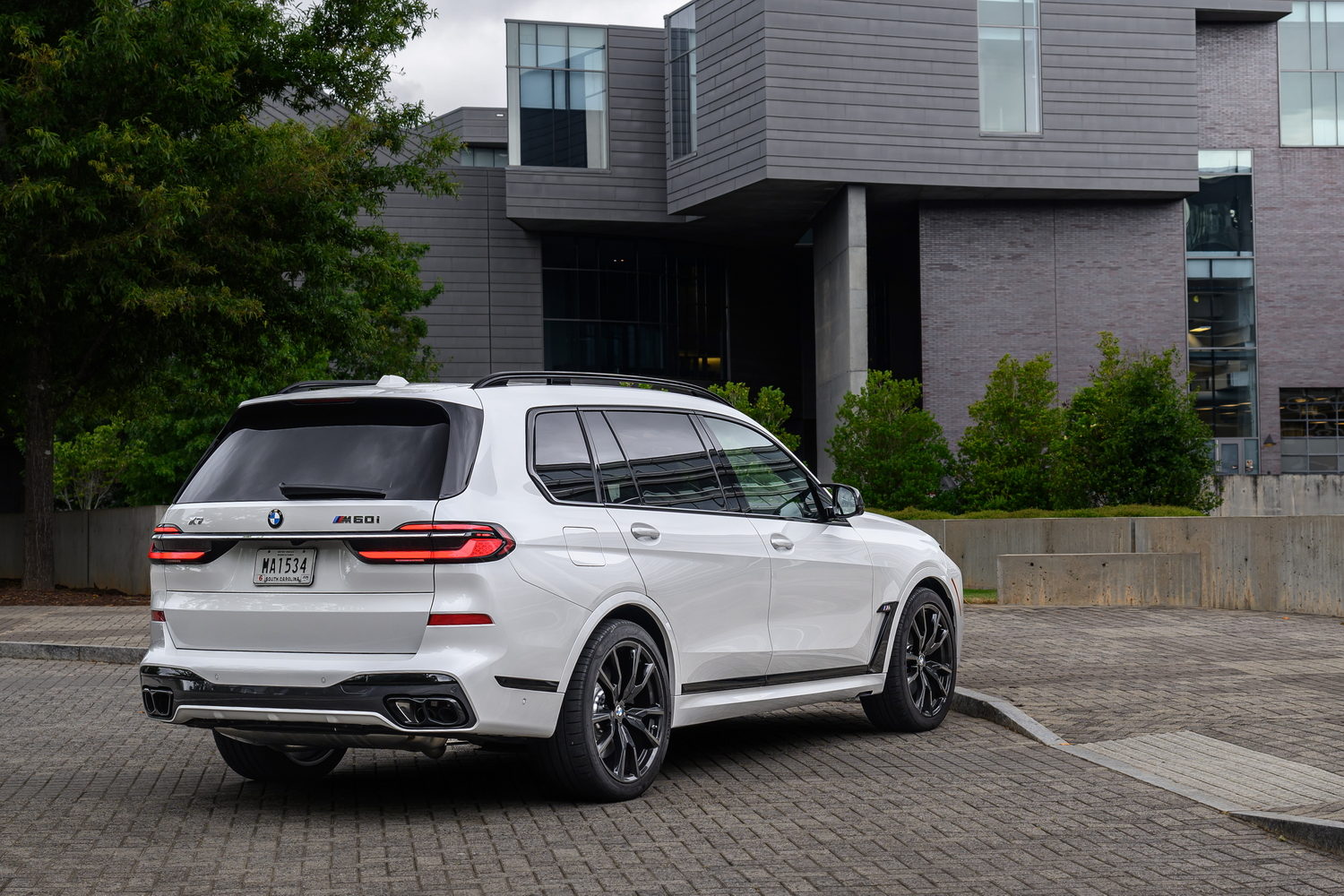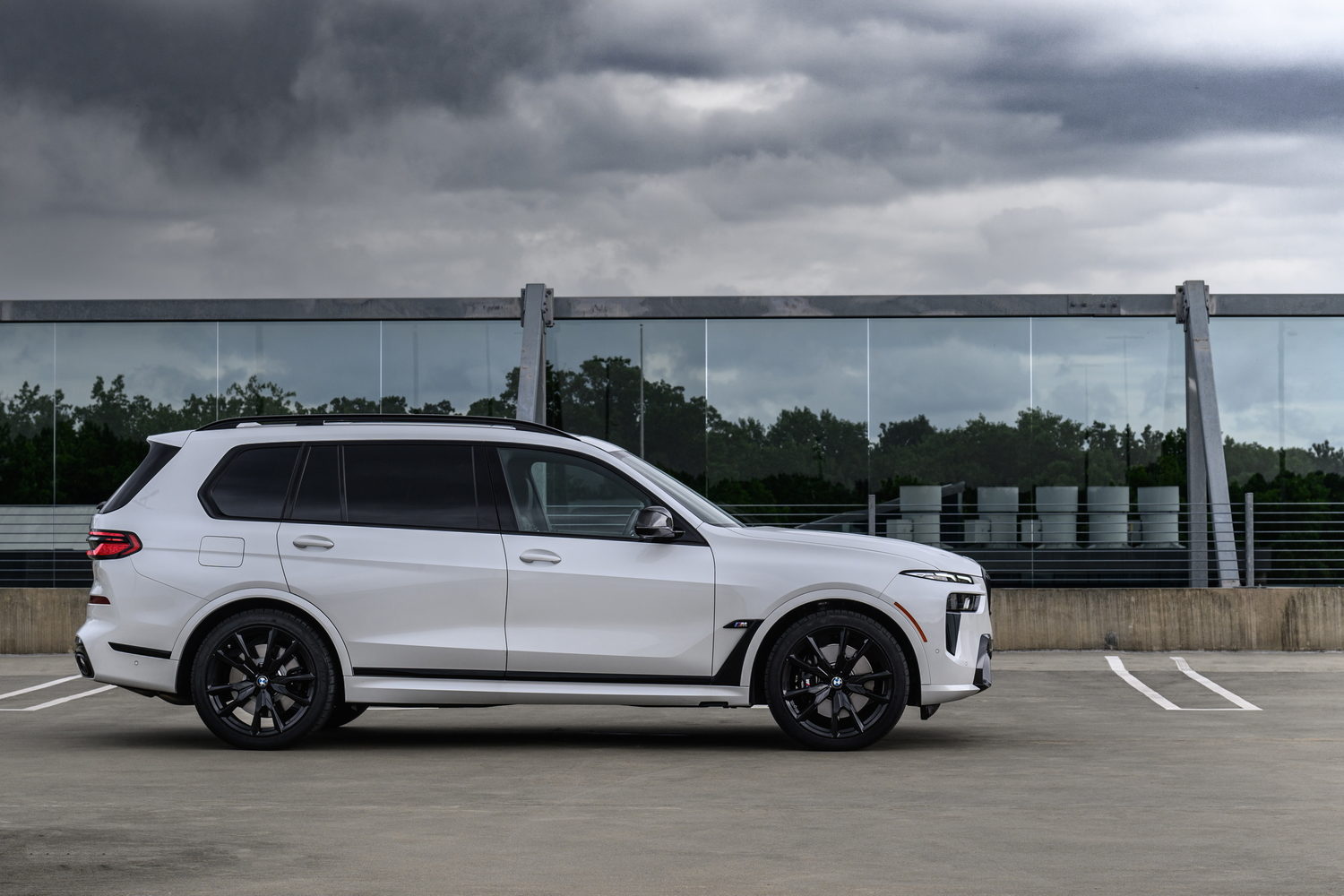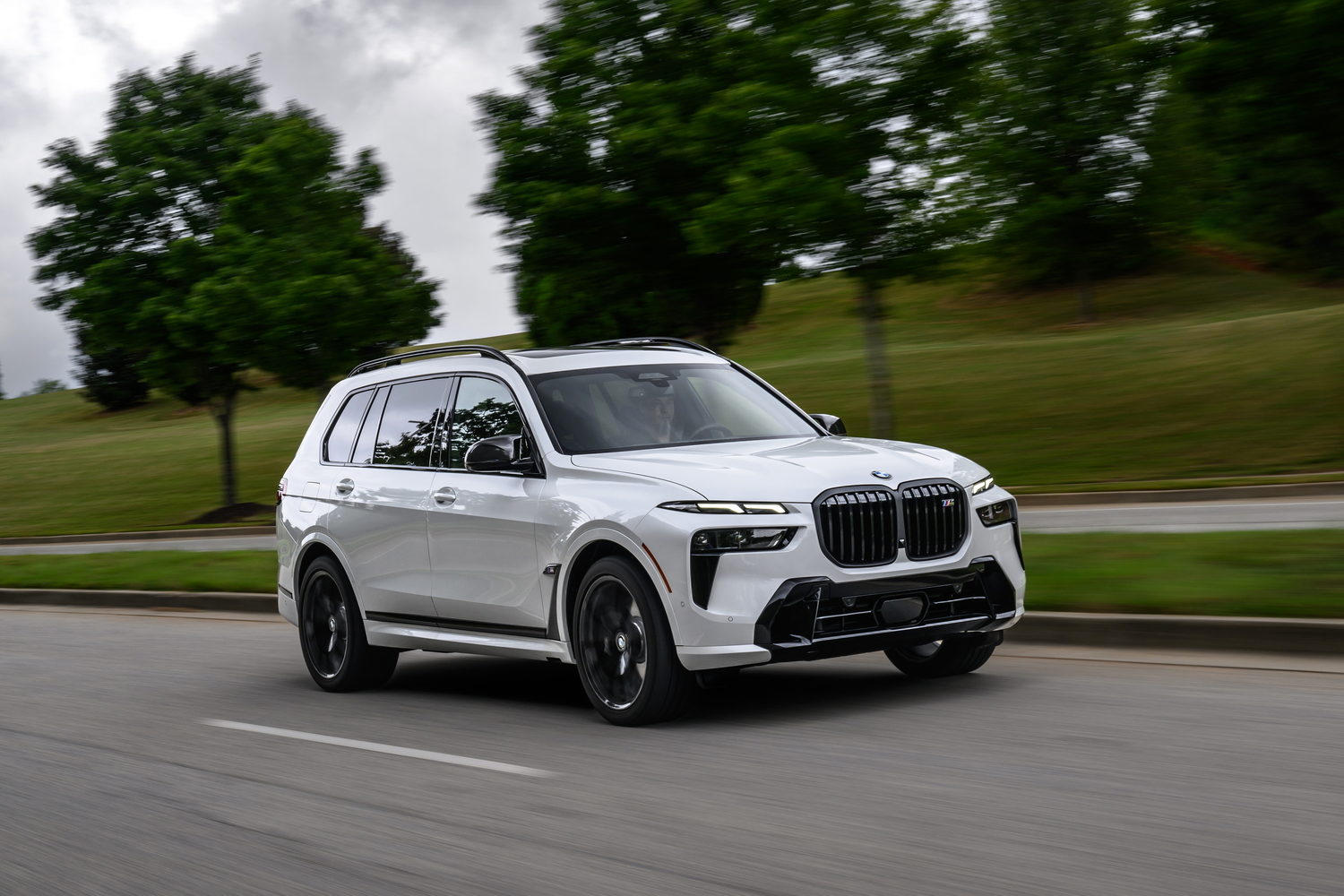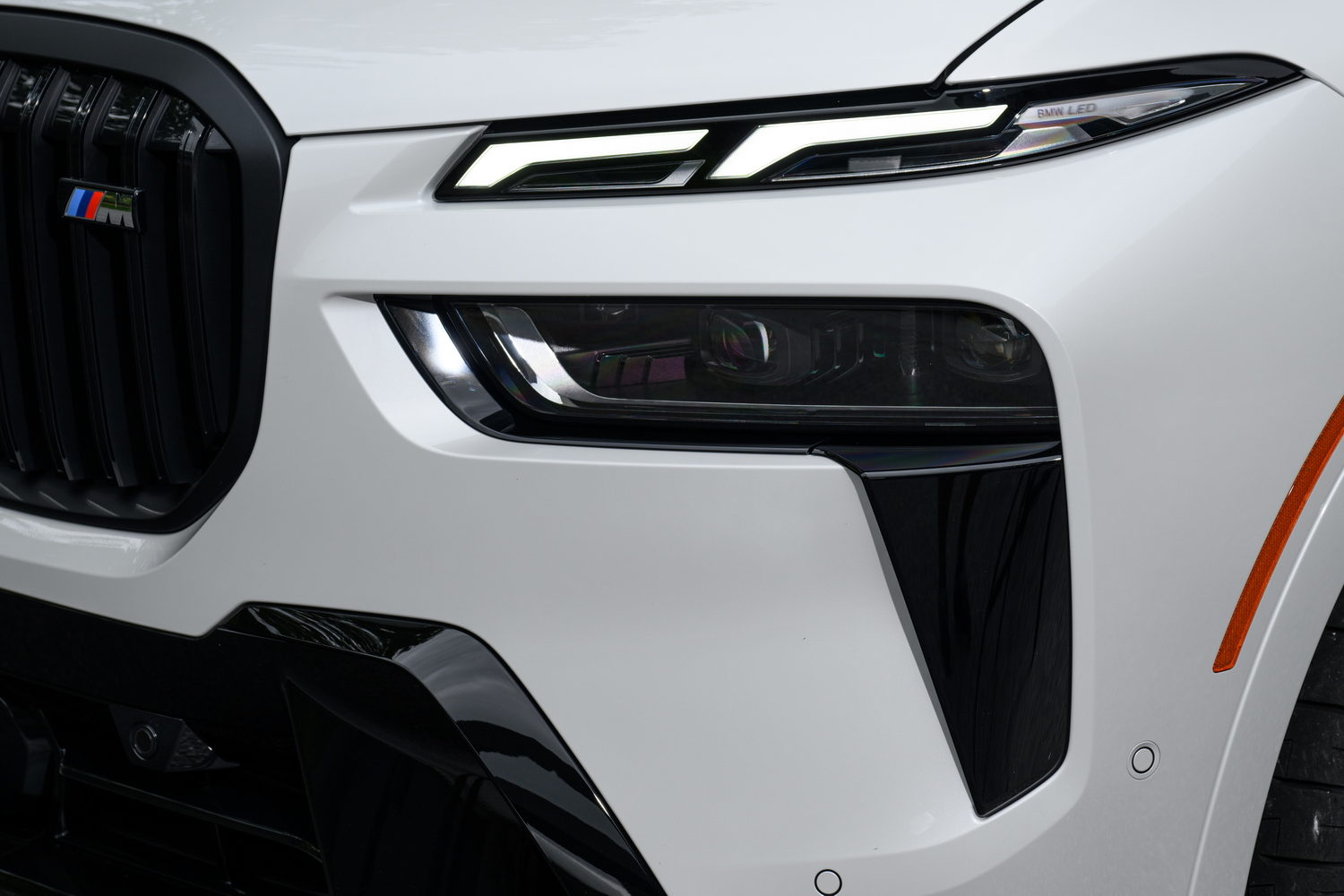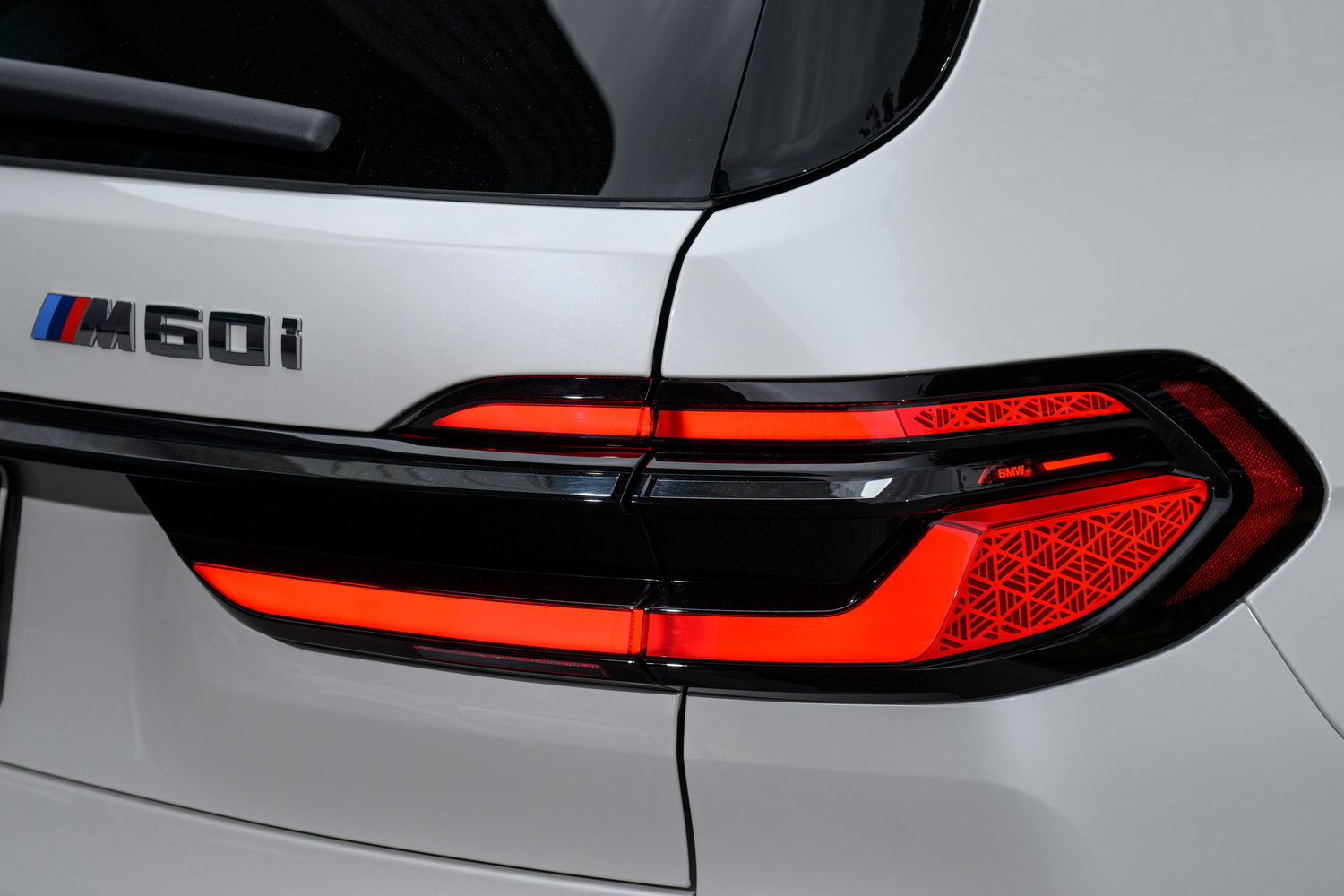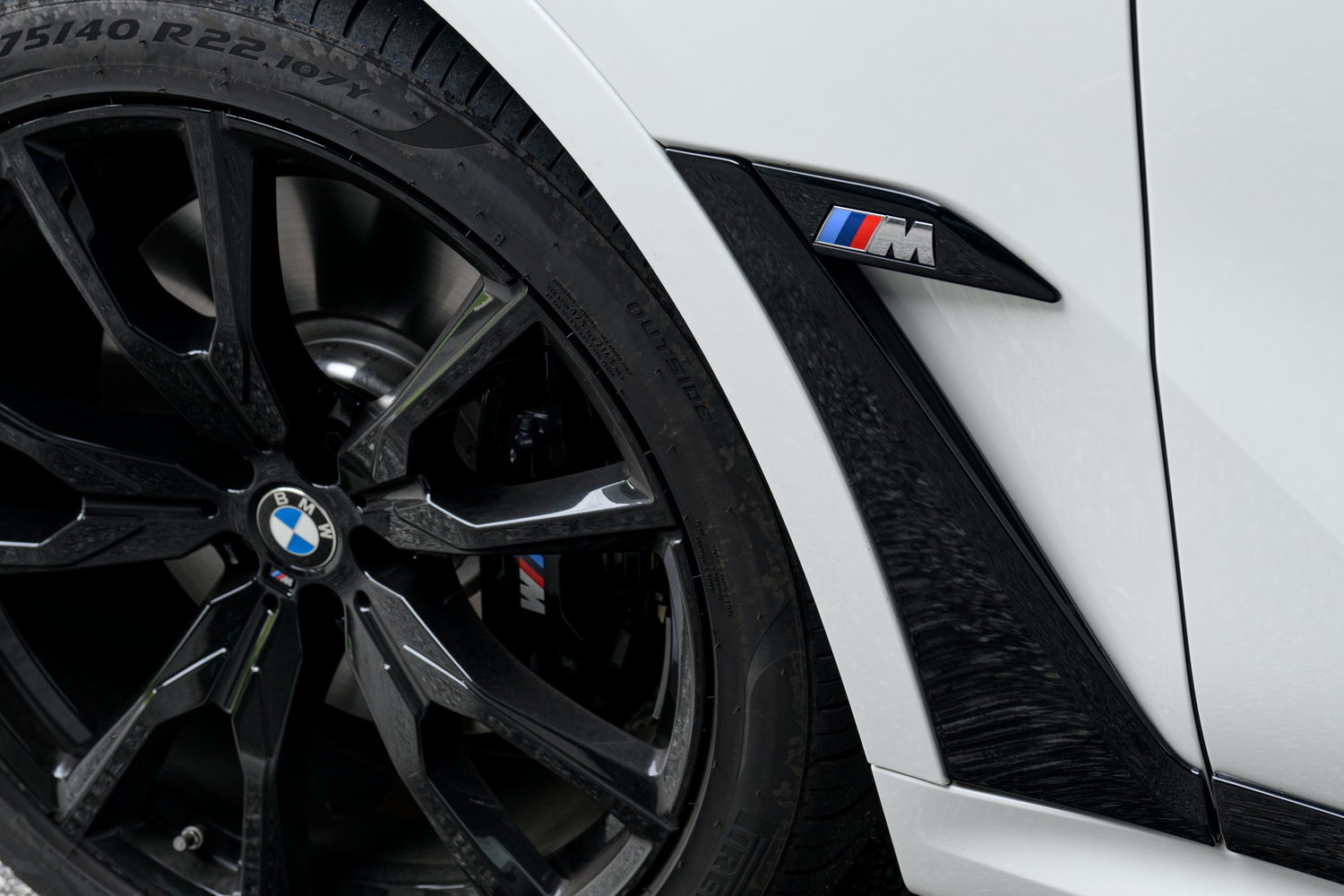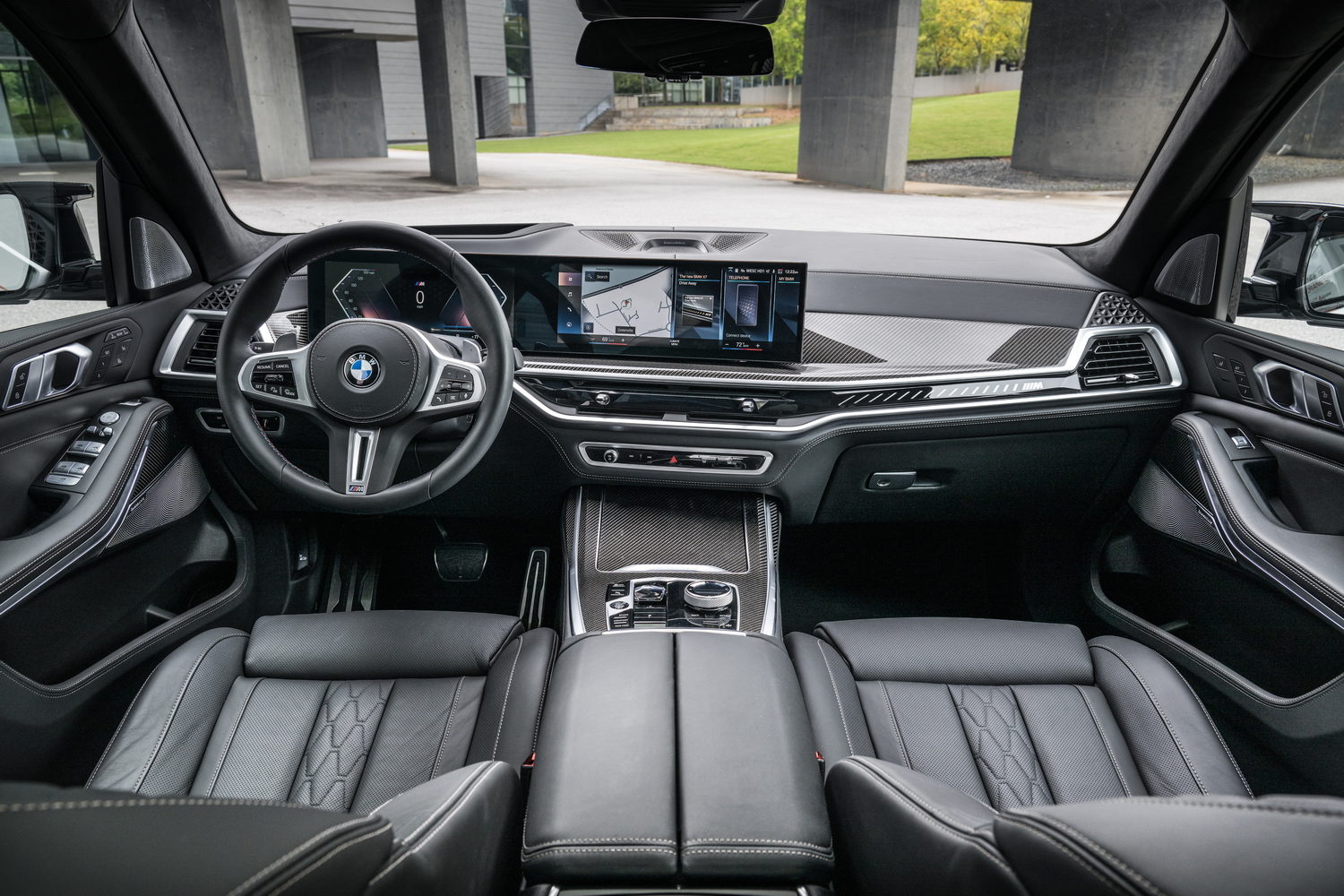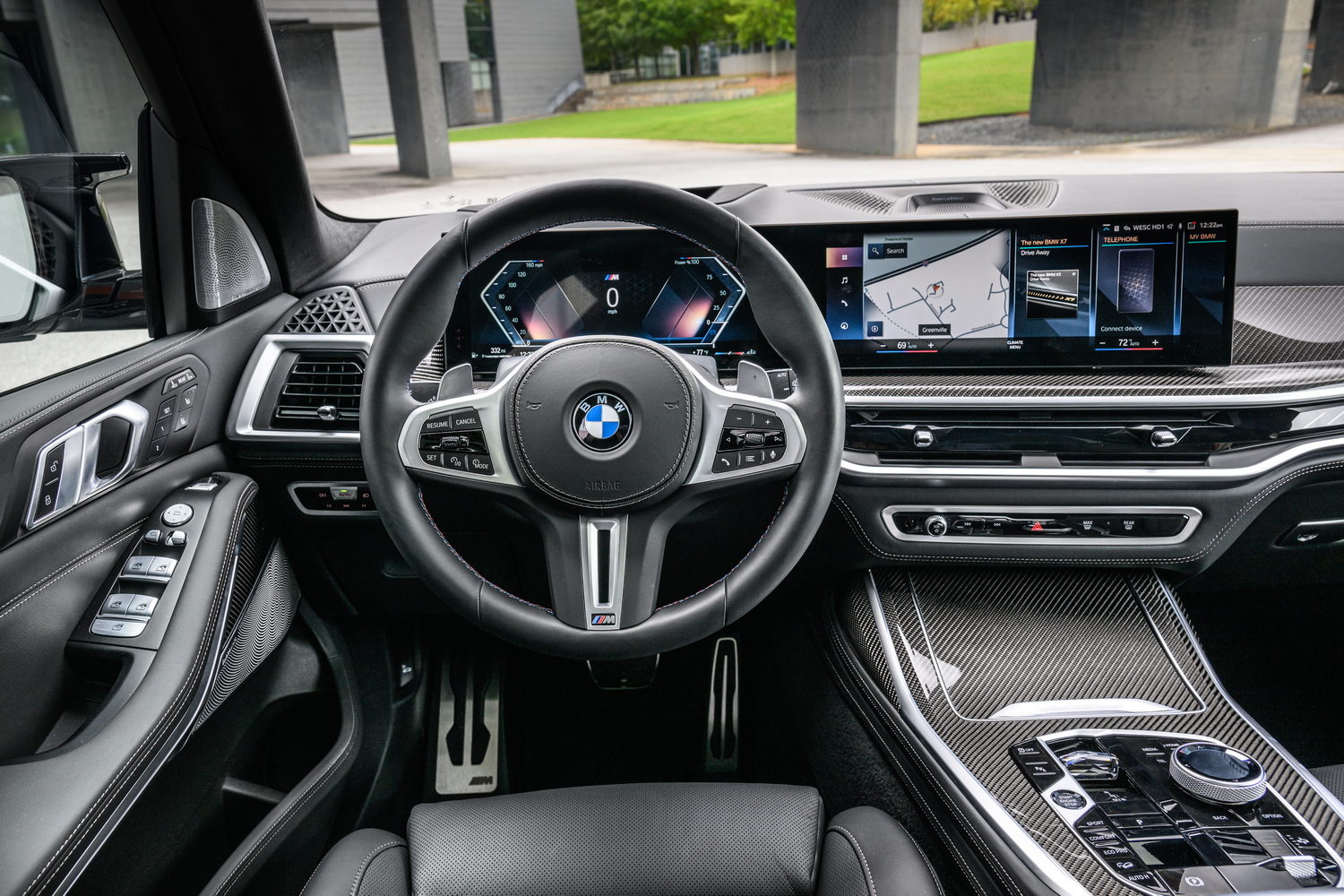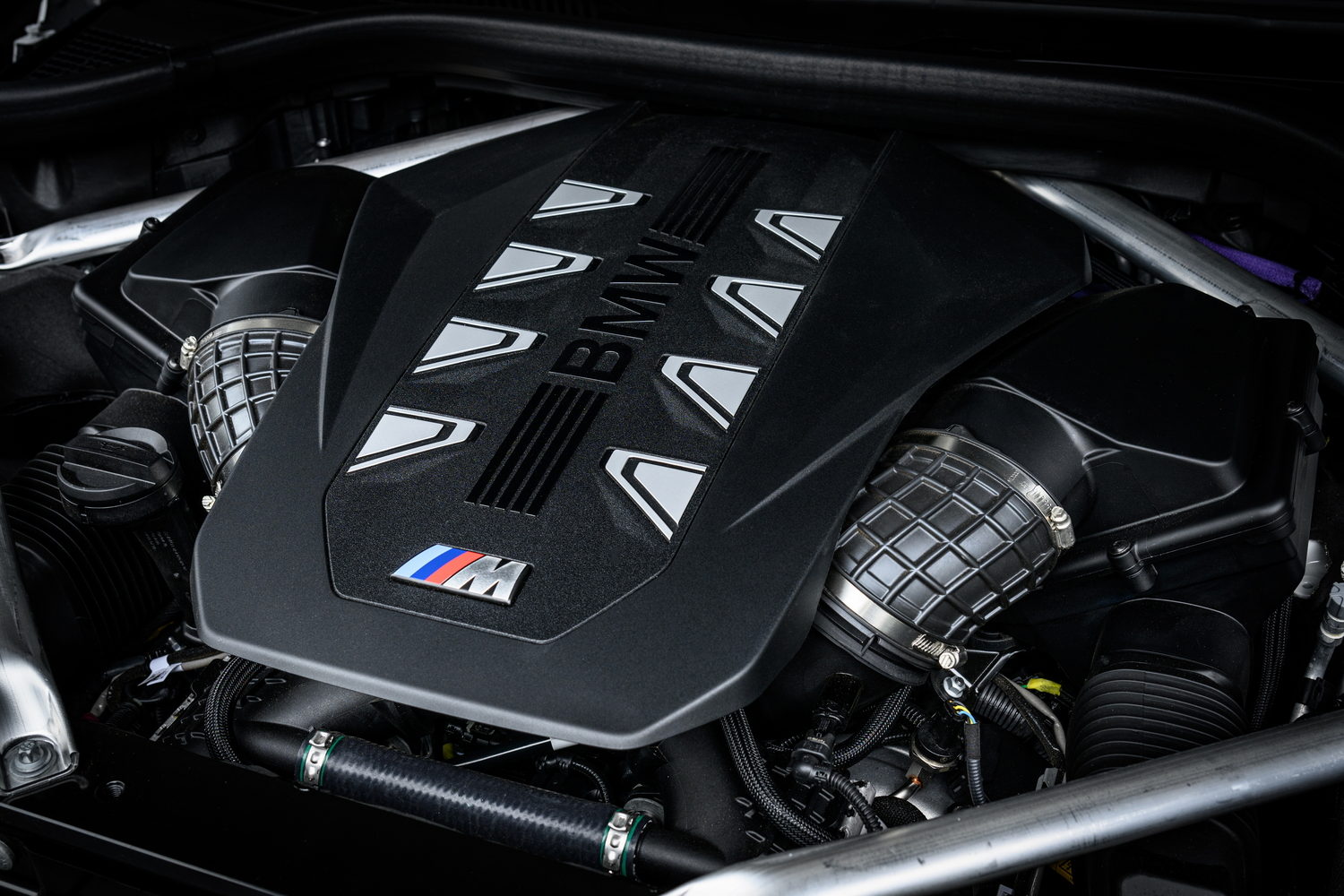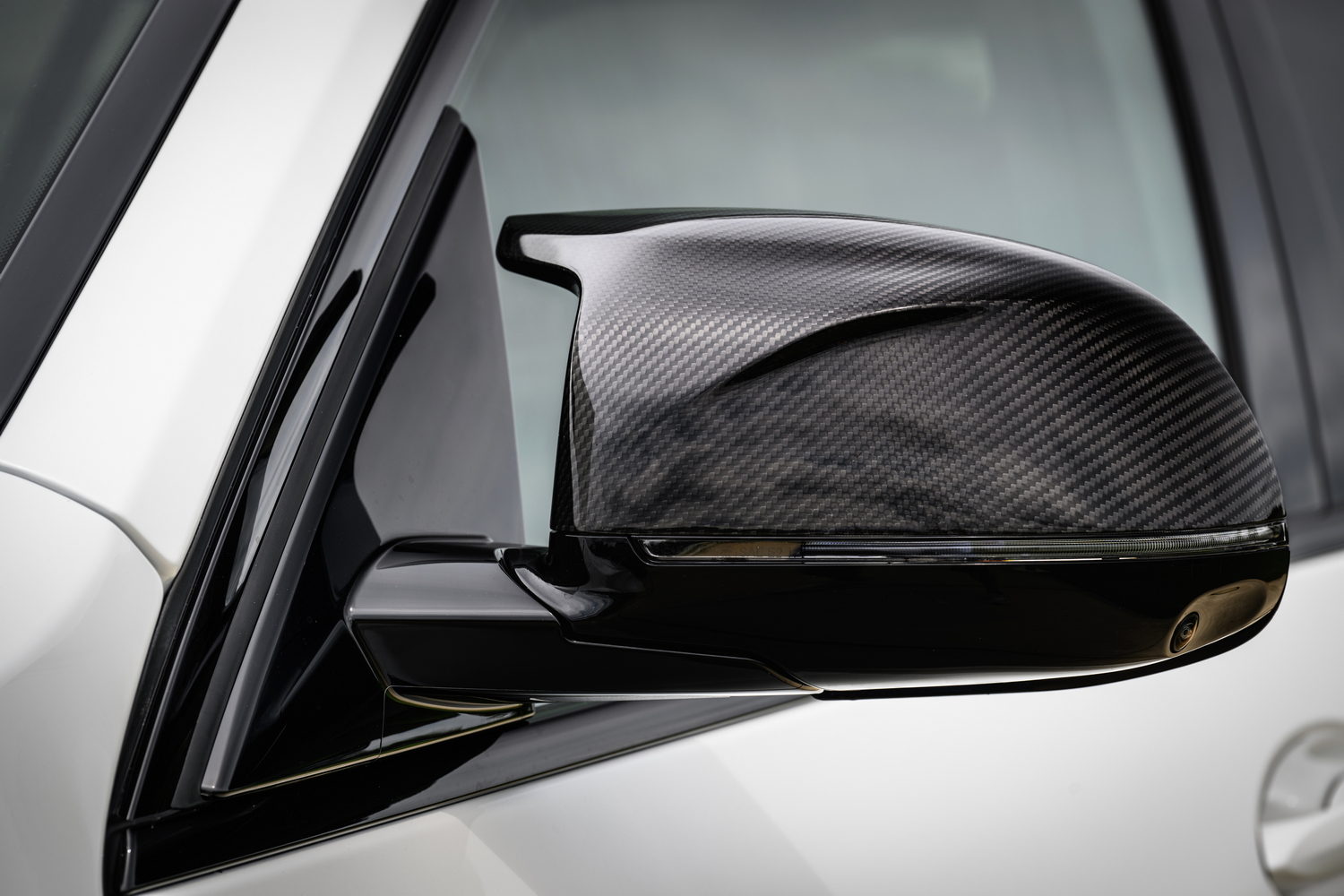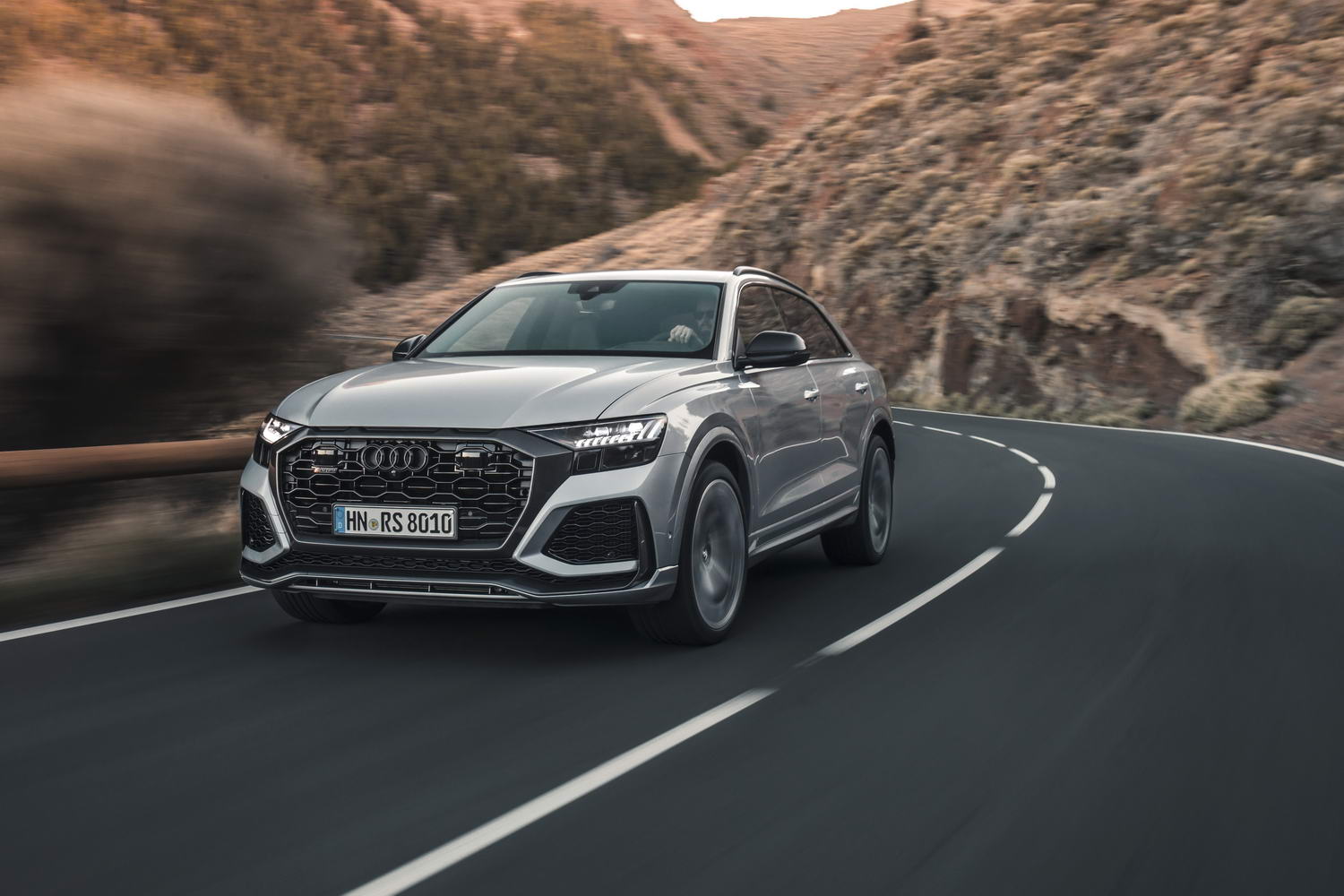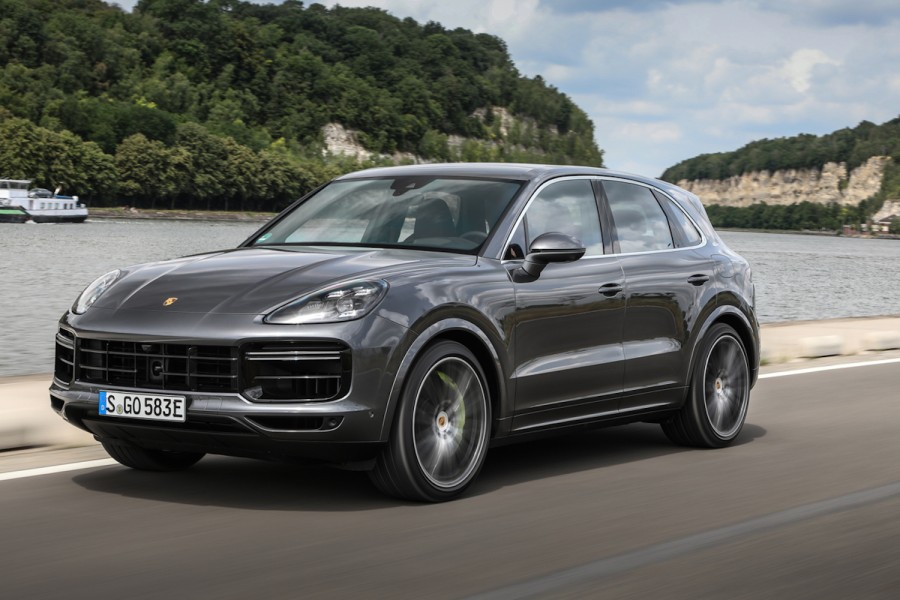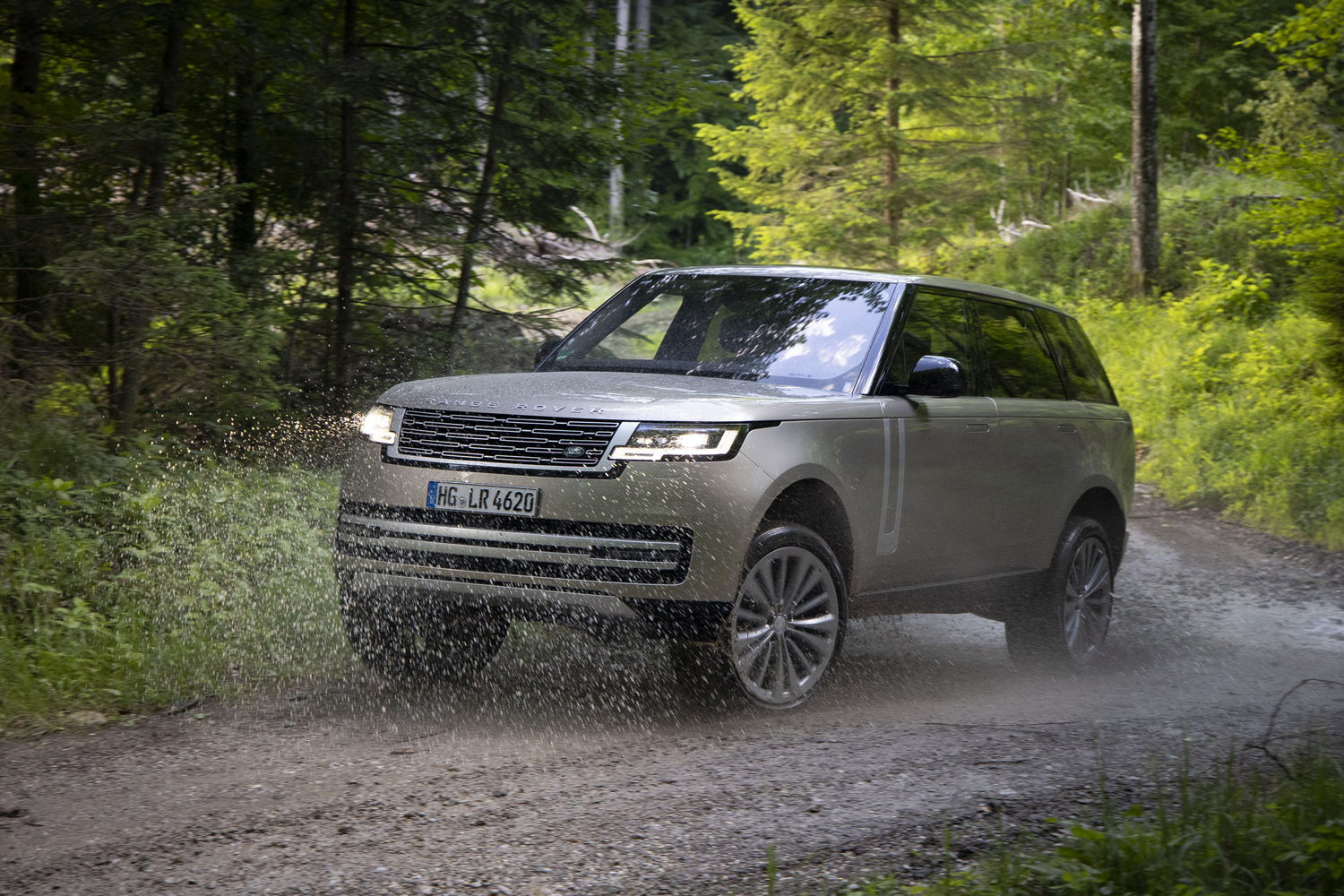Go big or go home: that could easily have been the mantra for the team responsible for the update to the BMW X7 SUV. And they didn't go home... The facelifted range-topper to BMW's X line-up gets an eye-catching new exterior design, a significantly revamped cabin and updated engines, including an M Performance model in the shape of the 530hp, V8-engined M60i under test here.
In the metal
Although the overall proportions and profile of the BMW X7 have not been altered, the appearance has been dramatically changed by the front-end styling. The large kidney grille has been given a modest makeover, including 'Iconic Glow' illumination as standard, while the detail design of the apron/bumper underneath varies depending on model. The M Sport and M Performance models get a larger lower air intake and black trim.
The most pronounced change, though, is to the X7's lighting. It features a new split-level design that will be shared with the BMW 7 Series and XM. Butting up against the bonnet are the low-profile LED daytime running lamps (doubling up as side indicators), which are separated from the main headlamp units underneath by a strip of painted bodywork. The inlets for the aerodynamic 'Air Curtains' are neatly integrated with the lower section, too. It all looks better in the metal than images portray, but it is quite a colour-sensitive design for sure.
BMW has revised the rear of the X7, too, but more subtly.
M Sport and M60i models get high-gloss black roof rails and other detailing where the X7 Excellence features an aluminium satin finish, while the M60i features additional black components, such as the exhaust outlets and parts of the kidney grille. The M60i is also fitted with 22-inch alloy wheels as standard, with the option to upgrade to a 23-inch design for the first time in BMW history.
Inside, the X7 still seats seven in its standard configuration, with the option to replace the middle row with two individual chairs. All are electrically adjusted and air conditioned. The rear doors are longer than the fronts to ease access. Lots of detail changes to the materials, colours and equipment have been carried out in the update, but the most obvious enhancement is the addition of the BMW Curved Display dashboard. In the X7, this incorporates a 12.3-inch screen for the digital instrumentation and a 14.9-inch touchscreen. If you don't fancy reaching out for it, you can still use the rotary iDrive controller, voice, or, if you can put up with it, gesture control.
Under the impressive looking curved display is a new stylised ambient light bar on the passenger side, while the dashboard itself is made from a leather-like, textured material referred to as Sensafin (leather is also available). As standard, there's soft leather upholstery, but buyers can opt for a non-leather alternative for no extra cost. While a three-piece glass sunroof (with electric blinds) is standard, it's possible to upgrade to the Sky Lounge option, which can generate its own starlit sky appearance.
With all three rows of seating in place, there's 326 litres of luggage space behind (300 in the M60i), expandable to a massive 2,120 litres if all the rear seats are folded down. The electric tailgate is split horizontally to ease loading (and create a ledge to sit on if wanted), and the air suspension lowers the rear of the car for the same reason when required.
Driving it
When the BMW X7 was first launched in 2019, its line-up included the M50i variant, powered by a twin-turbocharged 4.4-litre V8 petrol engine making 530hp and 750Nm of torque. The new M60i's peak figures are, curiously, no different, though it's a new engine co-developed by BMW and BMW M for use in a wide range of models. It's clearly capable of higher outputs, but the decision was made that the M60i didn't need any more performance.
The maximum outputs only tell some of the story, however, as the new engine is lighter and more efficient than before. It's also bolted to a new version of the company's ZF-developed eight-speed automatic gearbox. It's called 'Steptronic Sport' in this guise, standard across the updated X7 range with launch control and a 'sprint' function for maximum acceleration. The bigger news, however, is that there's now a 9kW electric motor integrated within the transmission housing, as part of the X7's new 48-volt mild-hybrid system.
This motor replaces the traditional starting motor and can act as a generator when the car is decelerating, charging up a small extra battery in the engine bay to efficiently power the car's ancillary systems when required. It also subtly helps the petrol engine out, mostly at low speeds, where it can add 20Nm of torque from a standstill. With such a torque-rich engine as this under the bonnet, it's impossible to detect the electric assistance, but it should theoretically enhance responsiveness and improve efficiency, too.
The V8 itself is a real gem, shrugging off the considerable weight of the X7 to deliver serious performance. It sounds great, as well. That's partly due to the introduction of a new variable exhaust system. Previously, this used flaps that were either open or closed, depending on driving mode, engine speed and throttle opening. Now, the amount the flaps are opened by can be varied, and BMW's engineers have calibrated it to give what it thinks is the best sound under all conditions, with a more pronounced note under full throttle or when in the Sport driving modes. Naturally, all this variability allows BMW to tune it to pass strict drive-by noise testing, too.
When ambling along in Comfort or Eco Pro modes, the engine is smooth and relatively quiet, if never silent. I can't imagine that anyone buying an M60i would want the engine to be inaudible at any time. The Sport setting is great for a drive on the open road or through the mountains, as it means a more responsive engine and gearbox, but without the unnecessary low-gear, high-rev focus of the OTT Sport Plus mode. There's a 'Sport Individual' option, too, allowing you to alter the damping, powertrain and steering settings to your preference.
And BMW has thrown every chassis system at this particular model. While all X7s get self-levelling air suspension with adaptive damping, the M60i also features Integral Active Steering (rear-wheel steering) and Executive Drive Pro. The latter is an active roll stabilisation system and it's incredibly effective, keeping the big heavy body of the X7 flat through corners, no matter how enthusiastically you take them. Crucially, it doesn't feel strange in operation - indeed, it just feels like the X7 is preternaturally composed, even when you push it further than any big SUV should be pushed. It makes for safe, rapid progress in all conditions.
Even on its 22-inch alloy wheels, the M60i proves to be comfortable over poorly surfaced roads. We tried the new 23-inch rims, too, and they notably worsen the ride quality at low speeds over irregularities. Choose them only if you are willing to make that compromise for the appearance.
Through a sequence of interesting corners, the M60i is incredibly impressive, poised, grippy and capable. The steering weighting is good and the Integral Active Steering helps with agility (as well as manoeuvring at low speeds), though when the reach the limit of the tyres' grip, you're informed by the noise from the tyres, not through the car's controls, so it would be a stretch to call this car engaging, despite its undeniable competence.
Of more relevance to most buyers, the X7 is the consummate long-distance cruiser, with low wind noise, hugely comfortable seats and a chassis that soaks up most of what's thrown at it. All of that is true in the M60i variant, too, though it has a sportier side.
What you get for your money
Irish pricing for the BMW X7 starts at €150,944 for the xDrive40d model in Excellence specification. It's less than €1,000 extra for the xDrive40i petrol model. The same powertrains are available in sportier looking M Sport guise from €156,495, while the range-topping M60i tested here starts at €192,545. All are incredibly well-equipped as standard as you'd hope with highly luxurious cabins, automatic transmissions and all-wheel drive in all. Also standard across the line-up are four-zone climate control, ambient lighting, panoramic glass roof, a Harman/Kardon sound system, a wireless phone charger and much more.
Yes, it's a lot of money by any measure, but really, the only direct rival on the Irish market is the new Range Rover, and that's more expensive like-for-like - though it can be had as a plug-in hybrid.
Summary
The BMW X7 was never designed with the Irish car market in mind, and the update to the big SUV, impressive as it is, reinforces that, especially as there will never be a plug-in hybrid version of this car. Nonetheless, as before, it takes all the luxury of the BMW 7 Series and packages it up in a taller vehicle with room for seven adults. The facelift gives the car even more presence, while the M60i ramps that up a further notch, with the performance to match. Naturally, that comes with high running costs. But that won't deter well-heeled buyers, and the X7 still offers those a good-value alternative to the Range Rover.

